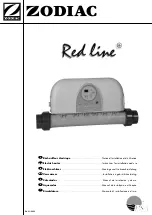
10
© 2021 United States Stove Company
OPERATION INSTRUCTIONS
TO CHECK FOR A LEAK
1. Make 2-3 oz. leak check solution (one part liquid
dish-washing detergent and three parts water).
2. Apply several drops of solution where regulator
connects to cylinder and to all hose and valve
connections.
3. Make sure all patio heater and light valves are
OFF.
4. Turn cylinder valve ON.
If bubbles appear at any connection, there is a
leak.
1. Turn cylinder valve OFF
2. If leak is at regulator/cylinder valve connection:
Disconnect, reconnect, and perform another
leak check. Apply the soapy solution to all hose
and valve connections.
3. If you continue to see bubbles after several
attempts, cylinder valve is defective and should
be returned to cylinder’s place of purchase.
If leak is at hose/regulator connection: This part is
defective and you should contact the customer
service department for replacement.
If NO bubbles appear at any connection, the
connections are secure.
NOTE: Whenever gas connections are loosened or
removed, you must perform a complete leak test.
Regulator / Cylinder connection
WARNING:
• Perform all leak tests outdoors.
•
Extinguish all open flames.
• NEVER leak test when smoking.
• Do not use the heater until all connections
have been leak tested and do not leak.
WARNING - CARBON MONOXIDE HAZARD:
For outdoor use only. Never use inside house,
or other unventilated or enclosed areas. This
heater consumes air (oxygen). Do not use
in unventilated or enclosed areas to avoid
endangering your life.
CAUTION:
Do not attempt to operate until you have read
and understood all General Safety Information
in this manual and all assembly is complete
and leak checks have been performed.
W
A
LL
CEILING
This appliance shall be used only in a well-ventilated
space and shall not be used in a building, garage or
any other enclosed area.
An appliance may be installed with shelter no more
inclusive than:
1. With walls on all sides, but with no overhead
cover. Always maintain a clearance of 1.2 m (47”)
from combustible materials from the top and
side.
2. Within a partial enclosure which includes an
overhead cover and no more than two side
walls. These side walls may be parallel, as in a
breezeway, or at right angles to each other.











































